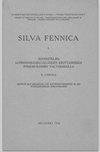From a rare inhabitant into a potential pest – status of the nun moth in Finland based on pheromone trapping
IF 1.7
3区 农林科学
Q2 FORESTRY
引用次数: 6
Abstract
Forests are affected by climate change in various ways. This includes abiotic factors such as droughts, but also biotic damage by pest insects. There are numerous examples from cases where pest insects have benefitted from longer growing seasons or from warmer summers. Similarly, new pest insects have been able to expand their range due to climatic conditions that have changed from hostile to tolerable. Such seems to be the case with the nun moth (), an important defoliator of coniferous trees in Europe. For centuries, the species has had massive outbreaks across Central-Europe, while it has been a rare inhabitant in Northern Europe. Recently, the nun moth population in Finland has not only expanded in range, but also grown more abundant. This research note describes the results from the first years (2018â2019) of a monitoring program that is being conducted with pheromone traps across central and southern Finland. So far, the northernmost individuals were trapped near the 64 N degrees. However, there were more southern locations where no moths were trapped. The species was present in every trapping site below the latitude of 62 N degrees. More importantly, at some sites the abundance of the nun moth suggested that local forest damage may already occur. Given the current climatic scenarios for Fennoscandia, it is likely that the nun moth populations will continue to grow, which is why systematic surveys on their abundance and range expansions will be topical.Lymantria monacha基于信息素诱捕的芬兰尼姑蛾从一种罕见的居民变成一种潜在的有害生物
森林以各种方式受到气候变化的影响。这包括干旱等非生物因素,也包括害虫造成的生物损害。有许多例子表明,害虫从较长的生长季节或较温暖的夏季中受益。同样,由于气候条件从恶劣变为可以忍受,新的害虫也能够扩大它们的活动范围。这似乎就是尼姑蛾()的情况,它是欧洲针叶树的重要落叶者。几个世纪以来,该物种在中欧大规模爆发,而在北欧则是罕见的居民。近年来,芬兰的修女蛾种群不仅范围扩大,而且数量也越来越多。本研究报告描述了在芬兰中部和南部使用费洛蒙陷阱进行的监测计划的第一年(2018 / 2019)的结果。到目前为止,最北的个体被困在北纬64度附近。然而,更多的南部地区没有捕获飞蛾。北纬62度以下各捕获点均有分布。更重要的是,在一些地方,大量的修女蛾表明当地的森林可能已经发生了破坏。考虑到芬诺斯坎迪亚目前的气候情况,修女蛾的数量很可能会继续增长,这就是为什么对它们的丰度和范围扩展进行系统调查将成为热门话题。Lymantria monacha
本文章由计算机程序翻译,如有差异,请以英文原文为准。
求助全文
约1分钟内获得全文
求助全文
来源期刊

Silva Fennica
农林科学-林学
CiteScore
3.50
自引率
11.10%
发文量
21
审稿时长
3 months
期刊介绍:
Silva Fennica publishes significant new knowledge on forest sciences. The scope covers research on forestry and forest ecosystems. Silva Fennica aims to increase understanding on forest ecosystems, and sustainable use and conservation of forest resources. Use of forest resources includes all aspects of forestry containing biomass-based and non-timber products, economic and social factors etc.
 求助内容:
求助内容: 应助结果提醒方式:
应助结果提醒方式:


